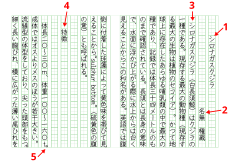Genkō yōshi facts for kids

1. Title on 1st line, first character in 4th square.
2. Author's name on 2nd line: 1 square between family name and given name, and 1 empty square below
3. First sentence of the essay begins on the 3rd line, 2nd square. Each new paragraph begins on the 2nd square
4. Subheadings have 1 empty line before and after, and begin on the 3rd square of a new line
5. Punctuation marks have their own square, except when they would occur at the top of a line. In that case they share a square with the last character of the previous line
Genkō yōshi (原稿用紙) (or genkoyoshi) is a type of Japanese paper used for writing. It is printed with squares. There are typically 200 or 400 squares on each sheet. Each square designed to accommodate a single Japanese character or punctuation mark.
Genkō yōshi may be used with any type of writing instrument — pencil, pen, or ink brush.
Genkō yōshi is used for vertical writing. On a sheet of genkō yōshi, there is no pre-determined order; there is instead a system of space, which can be designed freely.
One page of Japanese with 400 characters generally equals 225-250 words in English. In other words, an essay of about 10,000 words would be the same as 40-45 genko yoshi.
History
Genkō yōshi came into common use in the Meiji period. Newspapers and magazines needed to count characters.
- Amherst College, Genkoyoshi
Images for kids
See also
 In Spanish: Genkō yōshi para niños
In Spanish: Genkō yōshi para niños


